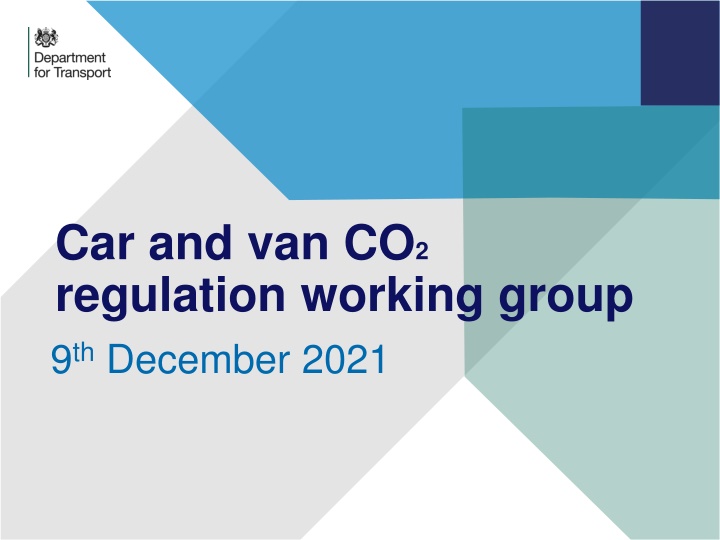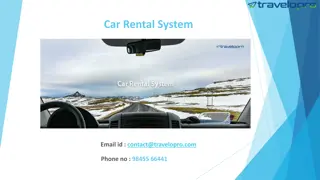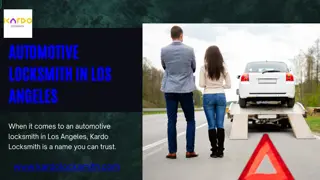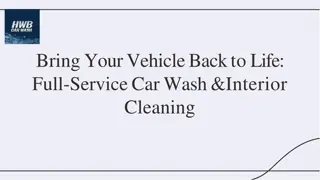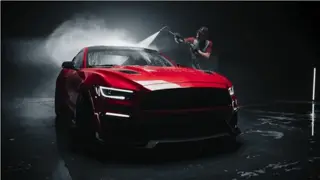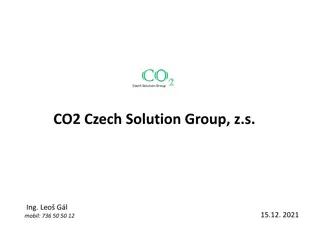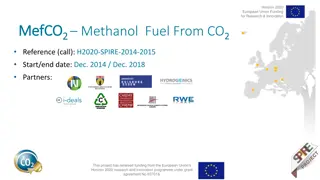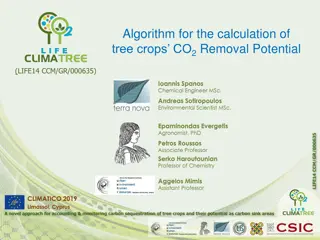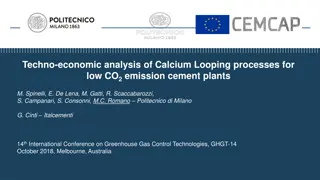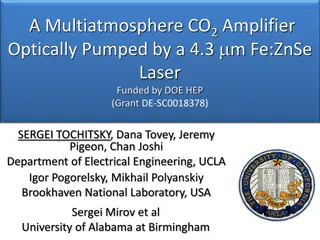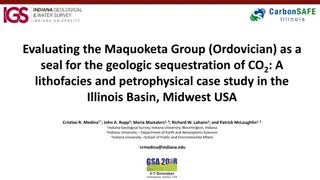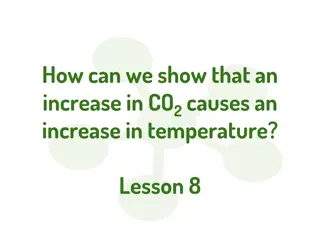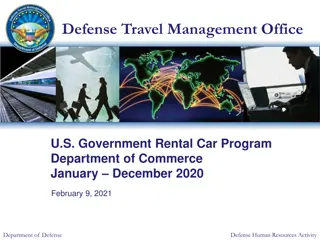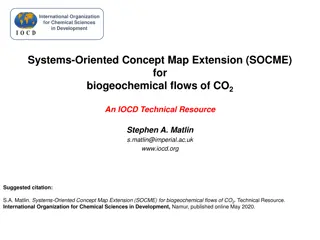Overview of Car and Van CO2 Regulation Working Group Meeting, 9th December 2021
The Car and Van CO2 Regulation Working Group convened on 9th December 2021 to discuss recent and upcoming legislative changes impacting CO2 emission regulations for vehicles. The meeting included agenda items such as collecting on-board fuel consumption monitoring data, manufacturer requirements for providing CO2 data on multi-stage vehicles, impacts of type-approval regulations, and the future development of CO2 regimes. Discussion also covered specific methodologies for calculating CO2 targets and the parameters to be collected from manufacturers. Additionally, the meeting addressed statutory instruments, regulatory updates for 2022-2024, and forthcoming changes for 2024-2029. Plans for evaluating full life cycle CO2 emissions reporting and implementing systems for verifying CO2 emissions for vehicles in service were outlined.
Download Presentation

Please find below an Image/Link to download the presentation.
The content on the website is provided AS IS for your information and personal use only. It may not be sold, licensed, or shared on other websites without obtaining consent from the author.If you encounter any issues during the download, it is possible that the publisher has removed the file from their server.
You are allowed to download the files provided on this website for personal or commercial use, subject to the condition that they are used lawfully. All files are the property of their respective owners.
The content on the website is provided AS IS for your information and personal use only. It may not be sold, licensed, or shared on other websites without obtaining consent from the author.
E N D
Presentation Transcript
Car and van CO2 regulation working group 9thDecember 2021
Agenda Agenda item Welcome and house keeping Recent and planned legislative changes Open forum discussion on collecting on- board fuel consumption monitoring data Approximate timings 14:00 to 14:10 14:10 to 14:30 14:30 to 15:00 15:00 to 15:25 Manufacturer requirements to send CO2 data on multi-stage vehicles 15:25 to 15:35 Comfort break 15:35 to 16:05 Impacts of the type-approval regulations on the CO2 regulations 16:00 to 16:20 Update on developing the future CO2 regime Any other business and close 16:20 to 16:30 Car and van CO2 regulation working group 9th December 2021
Recent legislative changes
Recent legislative changes Statutory Instrument (SI) 2021/1242 Passenger car M0 value for 2022-24 = 1435.77kg Methodology for specific manufacturers to calculate CO2 targets, those impacted include: Manufacturers with no CO2 emissions in 2020; Manufacturers who are new to market from 2021 onwards; Manufacturers who merge together to become a new manufacturer; Manufacturers who have been granted certain derogations in 2021 and Manufacturers who are new to market and eligible for a derogation from 2021. The data parameters to be collected: Collect date of first registration from DVLA and road load coefficient, frontal area and tyre rolling resistance from manufacturers on request from VCA. Removed deviation and verification factors and total number of new registrations. Updated contact details from Environment Strategy s to the VCA s. Car and van CO2 regulation working group 9th December 2021
Upcoming legislative changes 2022 Correcting retained EU eco-innovations; Updating the B0 value for 2022- 24 (Annex III multi-stage vans); Updating the definition of a manufacturer in line with type-approval legislation; Updating vans M0 value for 2024 to 2029; Correcting a few typos e.g. Annex I, Part A, point 5 and Mandating how we will collect real world CO2 emissions data. Future Evaluate the possibility of developing a methodology for the assessment and reporting of full life cycle CO2 emissions of a car and van by no later than 2023. Developing a system to verify CO2 emissions for vehicles in service. Car and van CO2 regulation working group 9th December 2021
On board fuel consumption monitoring
OBFCM data collection in the UK Article 12 Real world CO2 emissions and fuel or energy consumption The UK is obligated to collect OBFCM data starting with newly registered vehicles in 2021, including VIN and fuel/energy consumption. By June 1 2023 UK will assess how fuel and energy consumption can be used to ensure official CO2 values, fuel and energy consumption remain representative of real world conditions. Reports will be produced annually starting in 2022 on the gap between the official and real world data collected. This will directly feed into how we adjust WLTP CO2 values to ensure they remain representative of real world CO2 emissions. Car and van CO2 regulation working group 9th December 2021
Open discussion: OBFCM data collection in the UK Questions Reflections on the EU process? Are dealership/repairers able to collect this information? Has much data has been collected this year? Any issues? Or suggestions from improvement? Can this method of data collection and transfer be easily implemented into the UK? Over the air (OTA) transfer What are current OTA capabilities in cars and vans? Are OEMs already collecting the required data parameters by OTA? Would significant investment in soft/hardware be needed? What are the limitations of this method? Currently in talks with the Driver and Vehicle Standards Authority (DVSA) regarding adapting the MOT process (period technical inspection). Car and van CO2 regulation working group 9th December 2021
Reporting UK CO2 emissions for multi- stage vans Guidance for manufacturers 9
CO2 emissions from new LCVs type approved in a multi- stage process. The specific emissions of CO2 of a multi- stage vehicle are allocated to the manufacturer of the base vehicle. The new interpolation method provided in Regulation (EU) 2017/1151 determines the CO2 emissions of an incomplete base vehicle. The base vehicle manufacturer should report the input values used for the interpolation method, as well as the resulting CO2 emissions and mass of incomplete base vehicles, to the VCA. The reported CO2 emissions from the incomplete base vehicle will be attributed to the base vehicle manufacturers CO2 target calculations, this is to reduce the burden of unknown CO2 emissions from completed vehicles on these manufacturers. Where the incomplete data is not reported by the manufacturer of the base vehicle, the CO2 emissions for the completed vehicle, as recorded during first registration process, will be used for CO2 calculations. 10
UK reporting by manufacturers of the base vehicle 1. VIN Where the completed vehicle is based on an incomplete base vehicle: 2. Vehicle family identifier 3. Monitoring CO2 emissions 4. Frontal area 5. Rolling Resistance 6. Monitoring mass 7. Mass in running order 8. Mass representative of the vehicle load 11
UK reporting by manufacturers of the base vehicle 1. VIN Where the completed vehicle is based on a complete base vehicle: 2. Vehicle family identifier 3. Specific CO2 emissions of the base vehicle 4. Mass in running order 12
Monitoring mass The monitoring mass shall be calculated in accordance with the following formula: Mmon = MRObase B0 MRObase B0 mass in running order of the base vehicle body mass value of 1.375 Mass representative of the vehicle load 28% of the maximum vehicle load 13
Frontal area Where the incomplete base vehicle belongs to a road load matrix family: frontal area of the representative vehicle of the road load matrix family, in m2; (i) (ii) the mean value of the frontal area of vehicle high and vehicle low of the interpolation family, in m2; (iii) the frontal area of the vehicle high of the interpolation family, in case the interpolation method is not used, in m2. In the case of an incomplete base vehicle that does not belong to a road load matrix family, the frontal area value of vehicle high of the interpolation family shall be used. 14
Representativeness of the monitoring CO2 value VCA shall compare the monitoring CO2 emissions reported by the base vehicle manufacturer with the average of the specific emissions of CO2 of the related completed vehicles. VCA shall inform the manufacturer of the base vehicle of the divergence found between those values. If the divergence is 4 % or more for two successive calendar years, VCA shall use the specific emissions of CO2 of the completed vehicles in the following calendar year to calculate the average specific emissions of CO2 of the base vehicle manufacturer or the pool in that year. 15
Calculating monitoring CO2 emissions of base vehicles Use interpolation method in points 3.2.3.2 or 3.2.4 of Sub-Annex 7 to Annex XXI to Regulation (EU) 2017/1151 Mass of the individual vehicle, TMind shall be replaced by the base vehicle default mass, DMbase. DMbase = MRObase x B0 + 25kg + MVL Where: MRObase B0 MVL mass in running order of the base vehicle body mass value of 1.375 mass representative of the vehicle load. 16
How to report the data to VCA Format of the data - CSV file using VCA template Upload the file to ShareFile (email fleetaverage@vca.gov.uk for details) Deadline for reporting the data 28 February 2022. 17
10 minute break
Type-approval and the CO2 regulations
Type-approval impacts on the CO2 regulations UK car and van CO2 regulations All manufacturer CO2 targets and performances are calculated on a UK wide basis. The regulations state that a manufacturer is responsible for not exceeding its UK CO2 target and if exceeded, will be responsible for paying any fine incurred. The current legal definition of a manufacturer is the person or body responsible to the approval authority for all aspects of the EC type- approval procedure in accordance with Directive 2007/46/EC and for ensuring conformity of production (EU type-approval) . When the new GB type-approval scheme is in place this definition will be updated to refer to domestic legislation. Car and van CO2 regulation working group 9th December 2021
Type-approval impacts on the CO2 regulations Vehicles sold in Northern Ireland As the EU type-approval regulations are listed in the Northern Ireland Protocol, vehicles sold in Northern Ireland need: EU type-approval, or UKNI approval from the VCA. To apply for EU type-approval a manufacturer will need to have a legal representative in the EU, and for UKNI type-approval a manufacturer will need a legal representative in either the EU or Northern Ireland. Car and van CO2 regulation working group 9th December 2021
Type-approval impacts on the CO2 regulations Vehicles sold in Great Britain Once the final GB type-approval scheme is introduced, all vehicles sold in GB will need GB type-approval except for the following exemptions: Vehicles covered by valid EU type-approvals issued by the EU 27 which were in the UK immediately before the end of the transition period (23:00, 31/12/20); Vehicles with EU type-approvals as issued by the VCA but not transferred to an EU approval authority at the end of the transition period; Qualifying goods imported from Northern Ireland with EU approvals and Products with UKNI approvals. To apply for GB type-approval a manufacturer will need to have a legal representative in GB. Car and van CO2 regulation working group 9th December 2021
Type-approval impacts on the CO2 regulations Once GB type-approval is in place, the definition of a manufacturer, who will be responsible for UK car and van CO2 emissions, will be a manufacturer s GB based legal representative. However, as aforementioned a manufacturers EU/NI based legal representative will be responsible for: The direct placement of vehicles in Northern Ireland. Placing of vehicles on GB market via the aforementioned exemptions and Therefore, a manufacturer s GB and NI/EU based legal representative will both be responsible for the placing of vehicles onto the UK market. The legal definition of who is the manufacturer will need to be expanded to incorporate both vehicles placed on to the UK market by either a manufacturer s GB or NI/EU based legal representative. Car and van CO2 regulation working group 9th December 2021
Type-approval impacts on the CO2 regulations Solution A possible solution is to link the GB-based and NI/EU-based representatives of the same vehicle manufacturer for the purposes of the UK car and van CO2 emissions regulations only. Do you have any comments on this approach? Are other options available to ensure that CO2 targets remain-UK wide, and remain enforceable? Car and van CO2 regulation working group 9th December 2021
Update on future CO2 regime
Update on future CO2 regime ZEV Mandate announced in the Net Zero Strategy. This will be accompanied by a CO2 regulation (acting as a backstop to ensure standards in the remainder of the fleet are maintained). Definition of 'Significant Zero Emission Capability' is still being worked through. Government aiming to publish response to the Green Paper in the New Year (including SZEC definition) Second consultation will follow in due course, consulting on the specifics of the proposed regime. ZEV Mandate will enter into force for cars and vans in 2024. Car and van CO2 regulation working group 9th December 2021
Any other business?
Thank you for attending. Contact information Policy team at Department for Transport Alexandra.Geraghty@dft.gov.uk James.Vickery@dft.gov.uk Environmental.strategy@dft.gov.uk Enforcement team at Vehicle Certification Agency fleetaverage@dft.gov.uk
